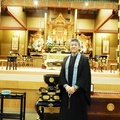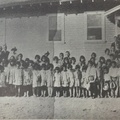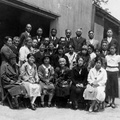The story is set in Tokyo just after the war. Jiro walks five kilometers to school every day to attend an elementary school attended by children from wealthy families in the educational district of the city center. There is something that Jiro cannot tell his classmates or teachers. Jiro has been abused by his father.
"A Story of a Baby Abandoned at Home" (published by Ronsosha in November 2016) is an autobiographical novel written by Kenji Irie, a Japanese doctor who actually lived in Los Angeles. In stark contrast to the shocking title, the writing style of this book is very bright and pleasant, and you can read it all the way through in one go.
Although the feelings of a child abused by his father are vividly portrayed, the book does not leave a gloomy impression after reading. This is because it describes the negative cycle of "from victim to perpetrator," in which the abused Jiro becomes a father and becomes violent toward his son Taro. The book ends with the author expressing his determination to bring domestic abuse to the world's attention and overcome it.
This book is a work of fiction, but when you compare the history that the author, Irie Kenji, reveals in his introduction to the book with the setting of the protagonist, Noro Jiro, it is easy to see that this novel is extremely close to Irie's autobiography.
In other words, the university Jiro entered, Tohto University, is the University of Tokyo, and the school Jiro attended from elementary school to high school, Tohto University of Education Affiliated, is an affiliate of Tokyo University of Education.
Tokyo University of Education affiliated school is an elementary, middle and high school that continues to exist as an affiliated school of the University of Tsukuba. Before the war, it had the status of a school for the children of wealthy private citizens, in contrast to Gakushuin, which was attended by members of the imperial family. Even immediately after the war, it continued to attract children from wealthy families in the city.
Jiro's father was a poorly paid English teacher who could not afford to live in an educational district, so he made his three sons, including Jiro, walk five kilometers one way to school. In this situation, Jiro could not fit in with the wealth of his classmates, but he made friends and was blessed with good teachers.
Jiro's family is depicted as being extremely poor immediately after the war, but considering that Japan as a whole was extremely poor at the time, Jiro's circumstances may have actually been relatively fortunate for Japan at the time.
The entrance exam study notes of Tokyo University students have always been a topic of interest to readers. I recall that in the 1960s, several entrance exam study notes of Tokyo University students were published.
In the case of the sensitive Jiro, while studying for the entrance exams, he is overcome by the obsessive feeling that he is not a person needed by society. In 1950s Japan, the top priority for young people was to go to engineering universities and work to revive Japan's industrial production, and every time Jiro's high school teacher talked about this, the message "You are not needed" resonated in Jiro's heart.
Jiro, who was not good at science but liked Japanese, even came up with the rhetoric to justify studying for the entrance exams: "The things I'm good at have no value, it's the things I'm not good at that have value."
But Jiro didn't give up. He dreamed of becoming a doctor, as a meeting point between what society wanted and what he was good at. This book is Jiro's dream come true memoir.
A frightening experience that makes one instinctively aware of death is called a "trauma," and Jiro's traumatic experience is recounted many times in "A Story of an Abandoned Baby at Home." In America today, the trauma of former soldiers has become a major social issue, as several thousand former soldiers commit suicide every year. One way to treat this problem is to talk about one's own experiences.
This book is also the author Irie's account of his traumatic experiences. By having the protagonist, "Jiro," re-enact his own experiences, Irie meticulously records how his own heart was hurt as a child. For Irie, who has experienced social change movements, it seems like a natural choice to make his traumatic experiences public in the form of a novel.
By describing his own experience of abuse in this book, Irie hopes to provide clues on how to escape the negative cycle of "victim to perpetrator."
The second part of "A Story of a Baby Abandoned at Home" tells the story of how Jiro felt he had reached the limit of his ability to survive as a doctor in Japan, and sought a solution by working in cancer research at a university in Los Angeles, leading him to travel to the U.S. He then met a Japanese man in Los Angeles who asked him to become a practicing physician for Japanese people who could not understand English, so Jiro obtained his U.S. medical license.
The second part can also be understood as a true story told by the author, Mr. Irie, and this chapter is also a modern immigration story. Most immigrants from Japan before the war were engaged in agricultural labor, but after the war, there was a "brain drain" of Japanese immigrants, and many Japanese with highly specialized knowledge went to America.
Author Irie published the non-fiction book "Little Tokyo: Irie Clinic" (Soshisha) in 1991. It is a memoir depicting the author's life from his 30s to his 50s. Irie is now approaching 80 years old, but "A Story of an Abandoned Baby at Home" tells the story that was left untold in "Little Tokyo: Irie Clinic" through the protagonist Jiro.
*This article is a reprint of a book review published in the Japanese version of the online newspaper Cultural News .
© 2017 Shigeharu Higashi







